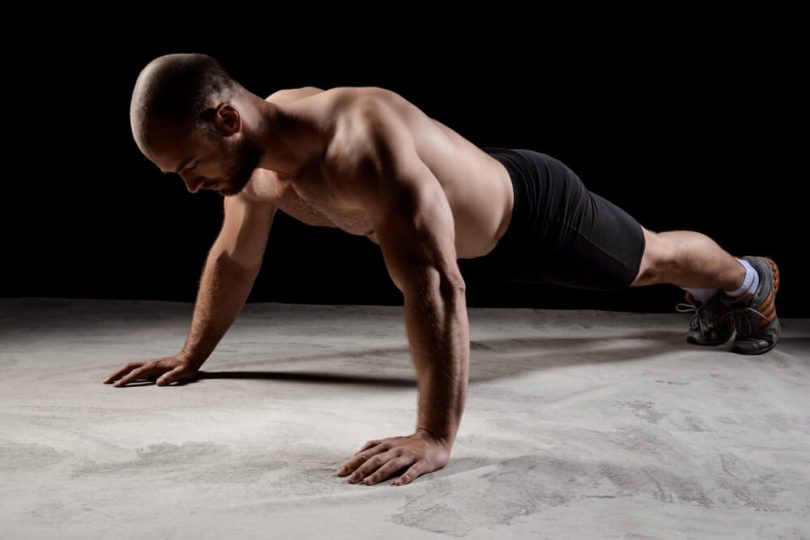There are many debates in the fitness world, and one of the hottest contested is the question of whether slow vs fast push ups – which is more effective.
Some people swear by doing slow push ups, saying that they provide a better workout for the muscles.
Others believe that fast push ups are more beneficial, because they work the muscles faster and add an element of cardio to the routine.
Slow vs Fast push ups – which is better?
Let’s take a look at both types of push ups and see what works best!
Slow Push ups
The slower you do a push up, the more time your muscles have to work. This makes them a great choice for people who want to focus on toning their muscles.
Slow push ups also require more control and can be a good way to improve your balance.
However, they can also be challenging if you’re not used to doing them, and you might find yourself getting tired before you’ve even finished a set.
Fast Push ups
Fast push ups are a great way to get your heart rate up and add an element of cardio to your workout.
They’re also perfect for people who are short on time, because you can complete a set much faster than you can with slow pushups.
However, if you’re not used to doing them, fast push ups can be hard on your muscles and joints. Start off slowly and increase the intensity as you get stronger.
Benefits of doing slow push ups as opposed to fast push ups
The benefits of doing slow push ups as opposed to fast push ups are many.
-
Slow push ups engage more muscle fibres
When you do a slow push up, you are engaging more muscle fibres, which means that you are working your muscles harder.
Slow push ups are great for building endurance and strength. They can also help improve your cardiovascular health.
Slow push ups can help increase the range of motion in your shoulders, which is beneficial for overall joint health. All of these factors make slow push ups a great choice for those looking to get the most out of their workout.
-
They improve your form
You are also able to focus on your form more when you do a slow push up, which can help reduce the risk of injuries.
They are great for improving your form. When you do a regular/fast push up, it is easy to let your form break down as you get tired.
However, when you do a slow push up, it is much easier to keep good form throughout the entire exercise. This will help you get better results from your workouts and avoid injuries.
-
Slow push ups are more challenging
Slow push ups are simply more challenging than regular push ups. This makes them a great way to mix up your workout routine and keep your body guessing. If you are looking for a new and challenging workout, then I recommend giving slow push ups a try.
There are many benefits to doing slow push ups, but the most important one is that they are better for overall muscle development.
How to do a slow push up
A slow push up is a great way to focus on your form and work on your strength. To do a slow push up:
- Begin in a plank position, hands slightly wider than shoulder width.
- Keep your arms and legs extended in a straight line.
- Slowly, lower yourself until your chest nearly touches the ground
- Pause at the bottom, then slowly push yourself back to starting position.
When doing a slow push up, make sure to keep your core engaged and your glutes and quads contracted.
You may find that you can’t do as many reps as with a traditional fast push up, but the quality of each rep will be much better.
If you’re looking to add a challenge, try doing slow push ups with your feet elevated on a stability ball or bench. This will place more emphasis on your chest and triceps muscles.
Tips for improving your slow push up technique
When doing slow push ups, make sure to keep your core engaged and your back straight. Try to lower yourself down slowly and pause for a second at the bottom of the push up before pressing back up.
This will help you build more strength in your chest and triceps.
If you find it too difficult to do slow push ups with good form, start by doing them on your knees. As you get stronger, you can progress to doing full push ups.
How to do a fast push up
A fast push up is a great way to get your heart rate up and burn more calories.
- Assume a plank position placing your hands slightly wider than your shoulders.
- As you lower yourself, make sure your body is in a straight line from your chin to your heels the entire time.
- Pause at the bottom, then as quickly as possible push yourself back to the starting position.
When doing a fast push up, make sure to keep your core engaged and your glutes and quads contracted.
If you’re looking to add a challenge, try doing fast push ups with your feet elevated on a stability ball or bench. This will place more emphasis on your chest and triceps muscles.
Slow Vs Fast Push ups
How many reps of slow push ups you should do each day
The answer to this question depends on a few different factors, such as your current fitness level and the goal that you are trying to achieve.
If you are new to working out, then you will want to start with a lower number of reps and gradually work your way up.
If you are trying to increase your muscle mass, then you will want to do a higher number of reps.
There is no one definitive answer to the question of how many slow push ups you should do each day.
Experiment with a few different rep counts and see what works best for you. As long as you are challenging yourself, you should see results.
Remember to focus on your form and maintain proper technique throughout the entire set of reps.
Slow push ups can be just as effective – if not more effective – than fast push ups, so don’t be afraid to take your time and do them correctly.
When should you do slow or fast of push ups
When you should use a slow push up:
- When you need to focus on your technique and want to make sure you are doing the move correctly.
- When you are new to push ups and need to build up strength.
- When you are rehabilitating an injury.
- When you are doing conditioning work.
When you should use a fast push up:
- When you are trying to increase your power output.
- When you are already strong and want to challenge yourself with more difficult variations.
- When you are short on time and need a quick but effective workout routine.
- When you are doing strength training exercises.
Although there are benefits to both types of push ups, ultimately it depends on what you are trying to achieve.
One of the great things about push ups is that there are so many variations to choose from. You can mix things up and keep your workouts interesting by trying different types of push ups.
Just be sure to focus on quality over quantity, and always listen to your body. If something doesn’t feel right, stop and take a break. Safety first!
Some of the most popular variations of push ups include:
- Slow push ups
- Fast push ups
- Clap push ups
- Wide arm push ups
- Narrow arm push ups
Slow Vs Fast Push ups – Variations
There are many variations of the slow or fast push ups. You can mix it up to make the exercise more challenging and fun. Some of the variations include:
- Slow and fast push ups with different arm positions (wide, narrow, shoulder-width, etc.)
- Slow and fast push ups with different hand positions (palms up, palms down, fists, etc.)
- Slow and fast push ups with different foot positions (wide stance, narrow stance, one foot forward, etc.)
- Slow and fast push ups with added weight (a weight vest, a backpack filled with books, etc.)
- – Slow and fast push ups combined with other exercises (mountain climbers, jumping jacks, etc.)
The possibilities are endless! Mix up the different variations to keep your workout interesting and challenging. You’ll see amazing results in no time!
Final Thoughts on Slow vs Fast Push ups
Both types of push ups are effective, so try doing both to see which works better for you. Remember to focus on form and not speed, because that’s what will get you the best results. Experiment and find what works best for you! Thanks for reading.








